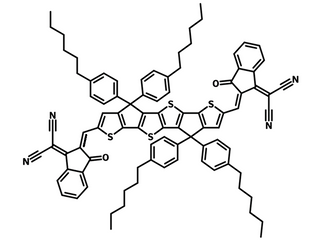IHIC, NFA with rigid planar structure to promote inter-molecular charge transport
Large quantity discounts available; buy online or request a quote today
Specifications | Pricing and Options | MSDS | Literature and Reviews
IHIC (CAS number 2127354-15-6), also known as 4TIC, has an acceptor–donor–acceptor (A–D–A) structure consisting of an electron-rich fused hexacyclic unit dithienocyclopentathieno[3,2-b]thiophene core and two electron withdrawing 1,1-dicyanomethylene-3-indanone (IC) terminal units. The rigid planar structure of dithienocyclopentathieno[3,2-b]thiophene promotes inter-molecular charge transport.
IHIC exhibits strong absorption in the NIR range of 600–900 nm with extinction coefficient of up to 6 ×105 m−1 cm−1and high electron mobility of up to 2.4 × 10-3 cm2 V−1 s−1.
When PTB7-Th was used as the low band-gap donor polymer with IHIC as the narrow-bandgap non-fullerene acceptor, excellent device performance was demonstrated with a high power conversion efficiency (PCE) of 9.77%. The active layer exhibits strong NIR absorption but weak visible absorption while giving the device a semi-transparent nature.
Device structure: ITO/ZnO/PTB7-Th: IHIC/MoO3/Au(1 nm)/Ag(15nm)[1]
| Thickness (nm) | VOC(V) | JSC(mA cm-2) | FF (%) | PCE(%) |
| 100 | 0.754 | 19.01 | 68.1 | 9.77 |
General Information
| CAS Number | 2127354-15-6 |
| Chemical Formula | C90H80N4O2S4 |
| Purity | ≥99% (1HNMR) |
| Full Name | 2,2'- [[4,4,9,9-tetrakis(4-hexylphenyl)-4,9-dihydrothieno[3',2':4,5]cyclopenta[1,2-b]thieno[2'',3'':3',4']cyclopenta[1',2':4,5]thieno[2,3-d]thiophene-2,7-diyl]bis[methylidyne(3-oxo1H-indene-2,1(3H)-diylidene) ]]bis-propanedinitrile |
| Molecular Weight | 1377.88 g/mol |
| Absorption | λmax796 nm (Film) |
| HOMO / LUMO | HOMO = -5.28 eV, LUMO = -3.87 eV [1] |
| Solubility | Chloroform, chlorobezene |
| Form | Dark blue powder/crystals |
| Synonyms | 4TIC |
| Classification / Family | NFAs, n-type non-fullerene electron acceptors,Organic semiconducting materials,Low band-gap small molecule, Small molecular acceptor, Organic photovoltaics, Polymer solar cells,NF-PSCs. |
Chemical Structure

Pricing
| Batch | Quantity | Price |
| M2239A1 | 100 mg | £360 |
| M2239A1 | 250 mg | £720 |
| M2239A1 | 500 mg | £1250 |
| M2239A1 | 1 g | £2300 |
MSDS Documentation
Literature and Reviews
- Fused Hexacyclic Non fullerene Acceptor with Strong Near Infrared Absorption for Semitransparent Organic Solar Cells with 9.77% Efficiency, W. Wang et al., Adv. Mater., 1701308 (2017); DOI: 10.1002/adma.201701308.
- Non fullerene Acceptors for Semitransparent Organic Solar Cells, S. Dai et al., Adv. Energy Mater., 1800002 (2018); DOI: 10.1002/aenm.201800002.
- Near-infrared organic photoelectric materials for light harvesting systems: Organic photovoltaics and organic photodiodes, B. Xie et al., InfoMat., 2, 57–91 (2020); DOI: 10.1002/inf2.12063.
Related Products
Semiconducting polymers for bulk heterojunction, OPV, OLED, OFET and perovskite interfaces and solar cell research.

 IHIC MSDS Sheet
IHIC MSDS Sheet
